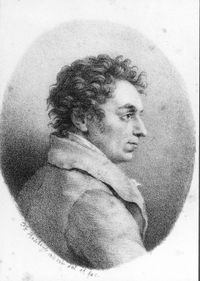Short Biography of Theobald Böhm
Theobald Böhm was born on 9th April 1794 in Munich as the eldest of 11 brothers and sisters. Already as a boy, he liked to occupy himself with mechanical works. At the age of 13, he entered the juweller’s shop of his father and soon became the most efficient worker.
At the age of 16 (1810), he took flute lessons with Johann Nepomuk Kapeller (1776–1825), who declared after two years that he could not teach him anything more. From 1812–1818, he was first flautist of the royal Isartortheatre, from 1818 on he was a member and then from 1830–1848 he was first flautist of the royal court orchestra in Munich. Between 1821 and 1831, he undertook vast concert tours which lead him among other places to Vienna, Prague, Dresden, Berlin, Leipzig, Zurich, Geneva, Venice, Strasbourg, London, and Paris. According to a letter from the Royal Bavarian Court Music Administration of 26th October 1830, he is “recognized as the best flautist in Germany besides Fürstenau in Dresden”, in one of the leading music encyclopedias of the 19th century, he is described as “one of the first flute virtuosi of Germany” (Mendel, H. / Reißmann, A.: Musikalisches Conversations-Lexikon. Berlin 1880, vol. 1, p. 68).
Theobald Böhm also had a great reputation as a flute teacher. He had more than 100 pupils, the most famous in Europe were Moritz Fürstenau (Dresden), Hans Heindl (Vienna), Karl Krüger (Stuttgart) and Rudolf Tillmetz (Munich), in the USA Martin Heindl (Boston Symphony Orchestra), Carl Wehner (New York Philharmonic Orchestra) and Eugen Weiner (New York).
At the age of 24 (1818), he started his education as a composer with practical lessons in composition with Peter von Winter (court chapel master from 1801 to 1825), who had studied with Antonio Salieri in Vienna like Beethoven and Schubert, and with theoretical lessons in composition with Joseph Grätz, who was trained in Salzburg by Michael Haydn like Carl Maria von Weber. From c. 1820 on, he was assisted in instrumentation by his friend Joseph Hartmann Stuntz (court chapel master from 1823 to 1837), a pupil of Winter and Salieri. In December 1820, Theobald Böhm played his Opus 1 “with never ending applause”. It was printed in 1822 by his flute pupil Joseph Aibl. The list of his musical works comprises 37 works with opus numbers and 54 arrangements without opus numbers, among them 26 arrangements for alto flute in G, alltogether about 2500 pages. 21 works and one arrangement can be played either with orchestra or piano accompaniment. The popularity of his works and arrangements shows not only in enthusiastic concert reviews and the recognition in music encyclopedias as “master pieces” (Schilling, Gustav: Universal-Lexicon der Tonkunst. Stuttgart 1835, vol. 1, p. 698), but also in the great number of reprints and new editions, about 300, of which the majority have appeared in France, Great Britain and the USA. Also, there exist today about 70 recordings with works of Theobald Böhm.
At the age of 34 (1828), he opened his own flute workshop. His first flute had been completed already 18 years before. He earned undoubtedly the greatest reputation with the invention of the conical ring-keyed flute in 1832 and the cylindrical flute in 1847, named after him. The most important innovations in 1832 were the correct position of the tone holes and the invention of a new key system, which enabled the player to open or close all 14 tone holes simultaneously with the 9 available fingers. The most important innovations in 1847 were the even more correct position of the tone holes (after acoustic studies with his friend Prof. Karl von Schafhäutl), the cylindrical bore with parabolic head, the use of the material metal, and from 1848 on, the covered keys. His flutes were awarded with gold or silver medals during the industrial and world exhibitions in Munich (1834, 1835, 1854), Leipzig (1850), London (1851) and Paris (1855). Whereas his flutes rapidly gained reputation abroad, particularly in France, Great Britain and in the USA, it took rather a long time in Germany, until they achieved their ultimate success. We can only speculate about the number of flutes made before 1847 (first workshop Theobald Böhm, 1828–1839, perhaps about 150 flutes; workshop Böhm & Greve, 1839-1846, perhaps about 100 flutes), the approximate number of the flutes made after 1847 results from the workshop ledger fragments (second workshop Theobald Böhm, 1847–1861, about 200 flutes; workshop Böhm & Mendler, 1862–1888, about 400 flutes). Today, there exist about 300 flutes from Theobald Böhm and his partners and successors, about half of which are in museums.
Besides flute making, Theobald Böhm made further important inventions in the field of production of musical boxes (c. 1816), piano construction (patent 1835), communication of rotary motion (silver medal of the Society of Arts, London 1835), improvement of iron (patent 1835; Knight’s Cross from King Ludwig I. for the introduction of the new procedure in the Bavarian steel factories, 1839) and the derivation and burning of the blast furnace gases (patent 1840). Furthermore, he invented a spark-proof locomotive chimney (patent 1841) and a telescope to locate fires (1841).
Theobald Böhm died on 25th November 1881 in Munich in the same house at Altheimer Eck 15, in which he was born. At the Old Southern Cemetery, section 12, he found his last rest.
